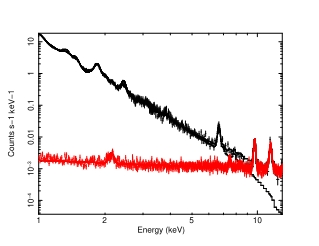NXB Spectral Models
This is a page to share template NXB spectral models developed by the XRISM team.
Link to respository to store associated files.
Xtend (ver.1)
NXB model: xtend_nxb_average.mo
Corresponding RMF: xtend_nxb.rmf
When fitting data and model, don't apply the source RMF and ARF to the background model, but use only the RMF above instead and without ARF. The model will be entered as model 2.
data 1:1 <data>
resp 1:1 <rmff>
arf 1:1 <arf>
resp 2:1 xtend_nxb.rmf
Resolve (ver.1)
rsl_nxb_model_v1.mo (first released empirical background model, nxb1)
newdiag60000.rmf (unity diagonal matrix for use with background model)
When fitting data and model, don't apply the source RMF and ARF to this background model, but use the diagonal RMF instead and no ARF. The model will be entered as model 2.
data 1:1 <data>
resp 1:1 <rmf>
arf 1:1 <arf>
resp 2:1 newdiag60000.rmf
The model is based on characterization of the spectrum produced from an event file derived from the total working preliminary NXB database, screened on EHK as described on the Resolve NXBDB page, and screened further on event parameters according to:
(PI>=600) && ((RISE_TIME+0.00075*DERIV_MAX)>46) && ((RISE_TIME+0.00075*DERIV_MAX)<58) && (ITYPE==0) && (STATUS[4]==b0) && (PIXEL!=27)
Note then that the model is presently based on 34 pixels and on H events only.
Description of the model
- The model is empirical and is intended simply to describe the background we measure, and not some fundamental spectrum that is altered by the instrument response.
- Because of this, the instrumental broadening of the lines is included in the model.
- power-law + 17 Gaussians + 3 scale factors that will be described in "How to use the model"
- Lines represented: Al-Ka1/Ka2, Au-Ma1, Cr-Ka1/Ka2, Mn-Ka1/Ka2, Fe-Ka1/Ka2, Ni-Ka1/Ka2, Cu Ka1/Ka2, Au-La1/La2, Au-Lb1/Lb2
- The lines are approximated as Gaussians although each line is really made up of multiple Lorentzians, each broadened by the LSF.
- This approximation was chosen because the statistics of the background do not justify specifying the known detailed descriptions of each line complex.
- For the Al, Cr, Mn, Fe, Ni, and Cu lines, we fixed the sigma parameter of the Gaussians at values consistent with fits of Gaussians to the same lines in high-statistics, ground-calibration data.
- The shapes of the Au lines were not available in the literature, thus they are entirely described by the fits to the background data file.
- Si-Ka1/Ka2 are not included in the model because these lines are also produced as part of the spectral redistribution of observed sources, which usually dominates. This redistribution is included in the XL RMF.
- Central energies of the lines are fixed to the values in https://xdb.lbl.gov/Section1/Table_1-3.pdf. (X-RAY DATA BOOKLET, Center for X-ray Optics and Advanced Light Source, Lawrence Berkeley National Laboratory)
- Sigmas of Gaussian models of Ka1 and Ka2 lines for each element are tied and fixed.
- Line intensity ratio of Ka1 to Ka2 is set to be 2:1 for each element.
- The model is valid for H events from 1 - 17 keV.
- The model is based on the premise that the spectrum (except for the Mn lines) is normalized by the cosmic ray rate but does not otherwise vary. The Mn lines should scale only according the the decay of Fe-55.
Pictorial overview of the Resolve NXB and current model
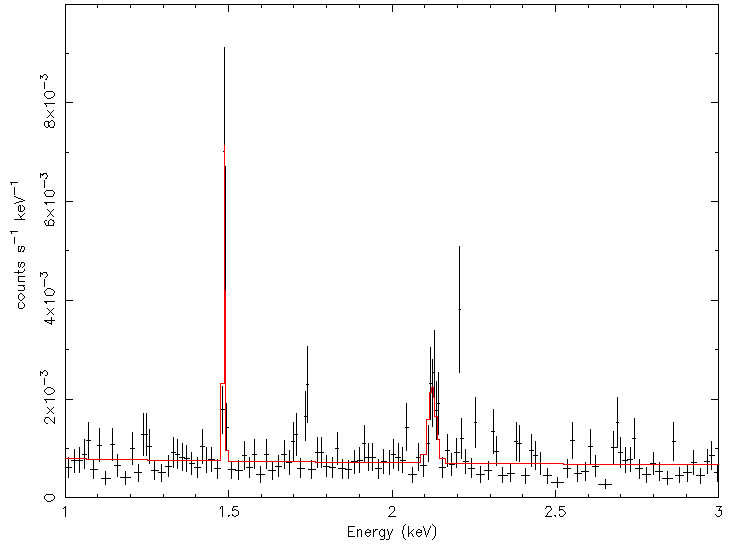


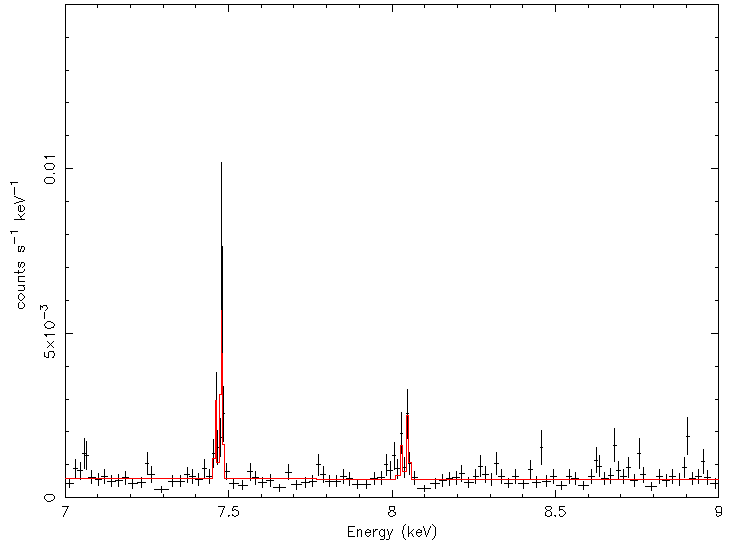
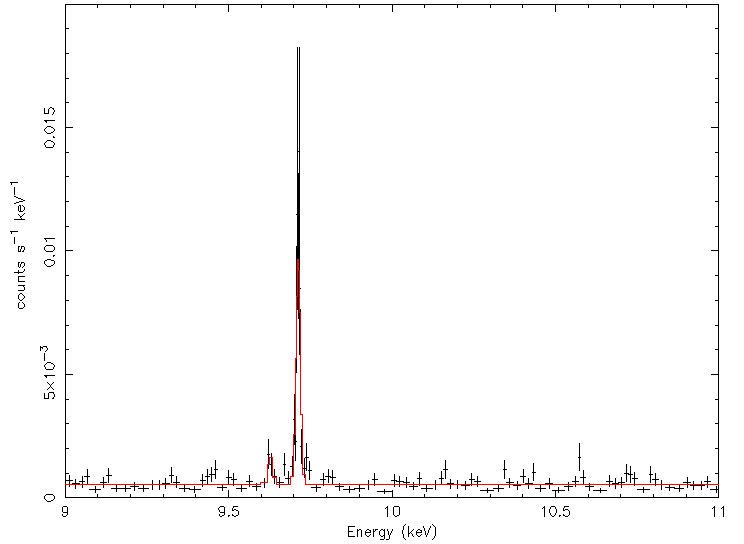
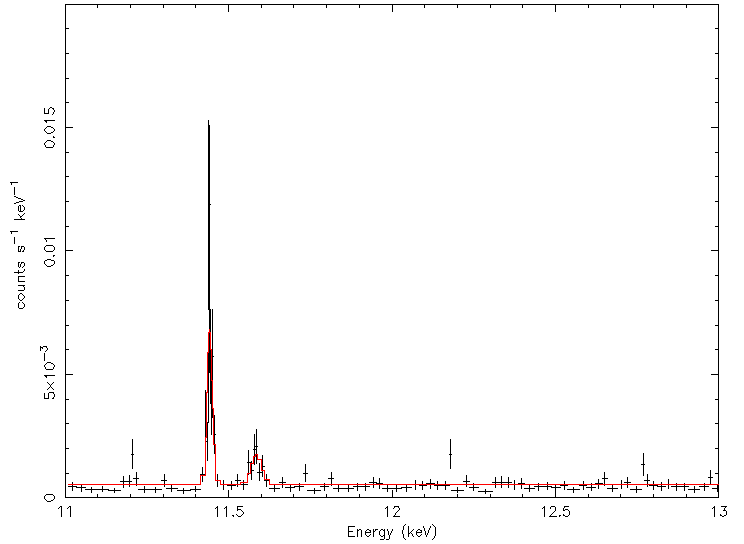


How to use the model
- The model contains 3 scale factors (nxb1:1, 4, 11) and 12 independent normalization parameters (nxb1:3, 7, 14, 20, 23, 29, 35, 41, 47, 50, 53, 56). These may never all be free at the same time!
- Parameters 1 and 11 control the scaling of the continuum and all the lines except Mn. These should remain tied together.
- nxb1:4 controls the scaling of the Mn lines. It would be redundant with nxb1:7 except for the restricted fitting range set for nxb1:7 (see discussion below).
- We recommend using rslnxbgen to create an NXB spectrum weighted by the COR distribution of the observation you are analyzing and starting by fitting that before doing joint fits with the source data.
- In the posted model file, all of the normalizations and scale factors are frozen except for parameter 1.
- All of the line energies are frozen and should be left frozen.
- The ranges for all of the parameter norms, the photon index, and the widths of the Au lines have been constrained to +/- 1-sigma from the fit used to determine these parameters.
- Even with a total exposure of 785 ks, the statistics in the Resolve NXB database result in error bars on the best-fit parameters that need to be considered when applying these parameters to individual observations.
- In order to account for this uncertainty, yet keep fits to the NXB in observations from producing unrealistic results, we recommend leaving the parameter ranges at the +/- 1-sigma values provided in the posted model.
- First fit the model as delivered, with all of the normalizations and scale factors frozen except for parameter 1.
- Note that the photon index and the widths of the Au lines are intended to be left free during this and the subsequent step, with the ranges constrained as specified in the model file.
- This is done to adjust the common scale of the particle-induced background.
- We do not expect that parameter 1 will need to vary much, as we expect the COR distribution within most individual observations to be similar to each other and to the NXBDB.
- To set an extreme example, we divided the NXBDB into two parts, COR < 10.67 and ≥ 10.67.
- The new best-fit values for nxb1:1 were 1.21 and 0.832, respectively. No real observation would have a COR distribution as extreme as these contrived COR mixes.
- Of course, if you are analyzing fewer than 34 pixels, nxb1:1 will need adjustment, accordingly.
- The distribution of scattered cal-source photons across the array is non-uniform, so for spectra using fewer than 34 pixels, scaling nxb1:4 by number of pixels is not appropriate; see below. Of the 64 counts between 5.88 - 5.91 keV, 8 of them are in Pixel 11, and 6 in Pixel 15.
- Note that the full 1 - 17 keV distribution across the array could also be somewhat non-uniform. The mean number of counts per pixel is 227.92, and the standard deviation is 16.65, whereas 15.10 would be expected for sqrt(mean).
- Next freeze nxb1:1, thaw nxb1:3, 7, 14, 20, 23, 29, 35, 41, 47, 50, 53, 56, and fit again.
- This is done to allow adjustment to the normalization of the individual parameters within the allowed +/- 1-sigma range
Limitations of the model and likely future improvements
- The shapes of the Au lines are currently not constrained by anything other than the fit to the integrated NXB. Resolve team members at LLNL are taking measurements now to help provide better constraints for these lines.
- We may also add Au Mb and Lg.
- There are suggestions of other lines in the data, but we did not have the statistics to constrain their normalizations. They must affect the description of the continuum to some extent.
- If the use of the Gaussian approximation causes problems in the fitting, the next step would be to use Voigt profiles constrained by fits to the ground data.
- There is a weak indication that the shape of the spectrum, in addition to the scaling, depends on COR.
- We compared the ratio of counts 12 - 17 keV / 1 - 12 keV for COR < 10.67 and ≥ 10.67 in the NXBDB.
- LOW COR hardness ratio = 0.34 +/- 0.01 (assuming sqrt(N) errors)
- HIGH COR hardness ratio = 0.36 +/- 0.01 (assuming sqrt(N) errors)
- This difference was also reflected in the spectral index and normalizations obtained for the power laws of the two parts, though in both cases the new results were (barely) within 1-sigma of the fit to the full data set.
- We expect that, since the effect is marginal when dividing the data into low and high COR values, variations in the COR distributions of typical data sets will correspond to negligible spectral variation.
- We look forward to increasing the statistics in the NXBDB so that we can characterize potential spectral changes.
- The model cannot account for transient changes in background, such as from unusual solar activity.
- Please continue to report unusual line energies or intensities.
- Consider the uncertainties when applying the full array model to a small subset of pixels.
|



